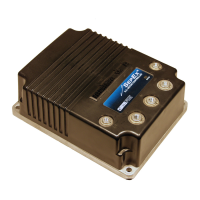A-10
Curtis 1244 Manual, Rev. E
APPENDIX A: GLOSSARY
Status LED
A Status LED (Light Emitting Diode) is built into the controller. It is visible
through the label located on top of the controller. e Status LED ashes a
2-digit fault identification code when a fault is detected by the controller. e
fault code continues to ash until the fault has been corrected and the fault
condition has been cleared. Clearing the fault condition typically requires cy-
cling KSI for faults detected during startup, and cycling the interlock switch
for faults detected during operation. e fault codes are defined in Table 6—see
Section 8, page 74.
Taper rate
e taper rate defines how gradually the vehicle slows down at the completion
of regen braking. e taper rate is programmable—see Section 3, page 27.
Temperature compensation for current limits
Full temperature compensation provides constant current limits throughout
the normal operating range (heatsink temperatures of -25°C to +85°C). e
temperature sensor that regulates the current limits is also used to calculate the
heatsink temperature displayed by the programmer.
Throttle braking
e throttle braking feature provides automatic braking when the controller’s
throttle input is reduced. e strength of braking is determined by the pro-
grammed rottle Braking Percent parameter value. rottle braking can be
disabled (i.e., set to 0%) if this feature is not desired. rottle Braking Percent
is a MultiMode™ parameter—see Section 3, page 36.
e rottle Braking Percent parameter together with the Decel Rate
and Restraint parameters allows the OEM to tune the vehicle’s performance in
response to reduced throttle, especially when traveling downhill—see Section6,
page 63.
Throttle deadband (neutral deadband)
e throttle deadband is the pot wiper voltage range that the controller inter-
prets as neutral. e throttle deadband is typically set at 10%. A higher setting
increases the neutral range, which can be useful with throttle assemblies that
do not return reliably to a well-defined neutral point. e throttle deadband
parameter is programmable—see Section 3, pages 30–31, and Section 6, page 55.

